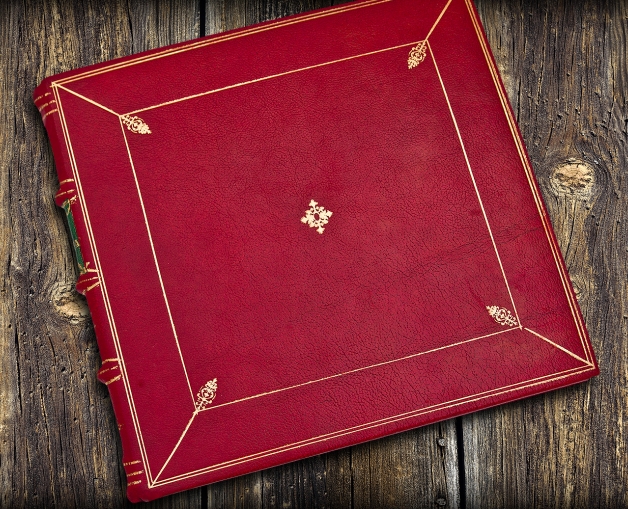Gladiatoria
Available: less than 40 copies
Medieval Martial Arts
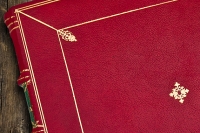 Gladiatoria
Gladiatoria
more >>
The Middle Ages are widely believed to be a period of decline and hence are often called the Dark Ages. This stereotype applies to all forms of human activity from that time, including the style of warfare. According to popular opinion, medieval knights mindlessly hacked away with their swords and brute force was the deciding factor to the outcome of battles. Most people think that disciplined fencing emerged only in the 16th century, along with the invention of the rapier. This approach is false, even unjust to medieval fencing which is closer to eastern martial arts than modern fencing. This is evidenced by medieval treatise devoted to fencing. They are a valuable source of information on this forgotten martial art. Today around 60 treatise survive containing selected experiences of masters of fencing with the longsword. These originate primarily from Germany and Italy. The earliest works on the matter date back to 1389, and the latest to 1612. The inspection of the treatise shatters the myth whereby the medieval warrior was but a mindless brute. Yes, strength was an indispensable element of the battlefield, but skill was crucial to victory and medieval swordsmanship was a complex, highly systematized martial art that was all but easy to master. Fencing required not only the use of various weapons, but applying the entire body – the pages of treaties show knights using joint locks or grappling techniques leveraging the force of the opponent against him, as well as wrestling. Another feature that
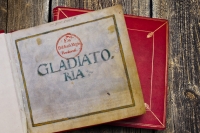 Gladiatoria
Gladiatoria
more >>
distinguished medieval swordsmanship from fencing with the épée or foil is the situations when it was used. While 18th century masters of fencing viewed it as a gentleman's occupation and prepared their pupils for duels that were bound with numerous rules, medieval masters of the longsword taught fighting to death, not only on the battlefield. This martial art was also used during so-called trials by combat where disputes were resolved by single combat. In such duels different weapons were used – depending on the case that needed resolving. Additionally, combat techniques without armour and weapons were developed. These were designed for fighting in regular clothing during unexpected attacks and ambushes that were not uncommon during these troubled times. There were different schools of combat (though most originated from and were inspired by the teachings of the first renowned master of the sword – Johannes Liechtenauer) and the masters teaching them started writing down their techniques, sometimes even illustrating them. It is our pleasure to present to you one such German Fechtbücher (combat manual) – the Gladiatoria.
Gladiatoria
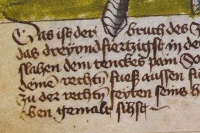 Gladiatoria
Gladiatoria
more >>
This anonymous text was created ca. 1430 in modern-day Germany and was written in the Early New High German language. Currently, there are six copies of this work, one is stored in the Library of the Jagiellonian University and the facsimile of this very copy stands before your eyes. This is the only version to feature a title page. Each parchment leaf of Gladiatoria features a drawing presenting a combat technique with a brief description on effective execution. The illustrations present a selected moment of combat and it is hard to deduct anything about the presented technique on their basis. The typeface used in the manual is called bastard, as it combines the features of diligent, calligraphic Gothic typeface with quick and cursive writing called italics. The upper right-hand corner bears the pagination, i.e. numbering, although this element was added in modern times. This manuscript features 59 leaves (which are numbered, as opposed to the pages), with each page, save for the first and last, presenting combat. The first presents a title and the stamp Die Preussische Koenigliche Staatsbibliothek in Berlin. The top of the page features the reference used to mark this manuscript in the Library
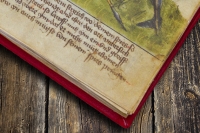 Gladiatoria
Gladiatoria
more >>
of the Jagiellonian Univeristy - Ms. Germ. Quart. 16 – which represents the name of this specific copy. The reverse side also features an annotation of the Staatsbibliothek in Berlin and a stamp. Two paper leafs were added to cover the manuscript and the cover itself most likely comes from modern times. The manuscript was discovered in the archives of the Library of the Jagiellonian University and restored to the world of science by Grzegorz Żabiński in 1999.
The techniques presented in the manuscript seem to originate from Johannes Liechtenauer’s school of fighting with the longsword or at the very least were heavily influenced by this famous fencing master. He was the first to collect and systematize different means of combat without creating his own martial art from scratch, but by developing existing ones. After Liechtenauer’s death, his students, in attempt to prevent the degeneration of the martial art by lesser masters and persons of common birth, started writing their own treatise. They made their own interpretations of Liechtenauer’s fencing principles. They also adapted the principles of fighting with the
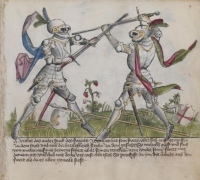 Gladiatoria
Gladiatoria
more >>
longsword to other weapons popular in the Middle Ages such as the falchion, dagger, lance, war hammer, buckler or special duel shields (classified as a weapon due to sharp spikes at the bottom and top). Gladiatorii features many of these weapons and combat techniques.
Most images from the treatise depict knights in a fairly diagrammatic form in full plate armor (so-called white armor to be exact, without any surcoat). Such armor was the invention of late Middle Age and the pieces presented in the images are characteristic of the first half of the 15th century. To protect the head fighters used a helmet called the close helmet fitted with a visor placed on two hinges that allowed knights to uncover their face without taking off the helmet. Later knights donned a gorget to protect the neck and collarbone. The torso was protected with a breastplate and back plate, together called the cuirass. The characteristic metal skirts protecting the lower stomach, hips and loins are called faulds. These were made from connected bands of metal (profiled, overlapping thin strips of metal attached to a leather underlayer). The arms from the collarbones to the hands were protected by spaulders (placed over the shoulder), rerebraces (covering the arm from the shoulder to the elbow), couters (elbow) and bracers (protecting the forearm from the elbow to the hand). The hand was usually
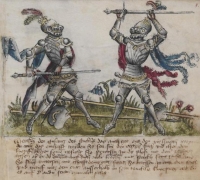 Gladiatoria
Gladiatoria
more >>
protected with leather gauntlets with riveted metal, partially overlapping plates, though the hands of knights in Gladiatoria are bare. The legs were protected by so-called leg harnesses composed of cuisses (stiff, metal leg protectors from the groin to the knee), poleyns (knee) and greaves (which protected the leg from the knee to the ankle). Feet protectors, made similarly to gauntlets, were called sabatons. Such armor ensured effective body protection – sensitive joints, where plates overlapped were protected with chainmail worn under the armor. The helmets of the knights from Gladiatoria were additionally adorned with crests with ribbons flapping behind their backs.
Each image is accompanied by a schematic presentation of the ground on which the knights are fighting with scattered weapons used in the previous scenes. The first seven leaves present techniques of fighting with the spear in full armor. In some situations one of the fighters uses a different type of weapon, such as e.g. the longsword or… a stone (leaf 7 recto). At least this is what the image tells us – the text only mentions using the iron gauntlet as a projectile. After the throw, which will cause the opponent to instinctively cover himself, the author recommends assaulting the foe with full force using the sword or spear. Additionally, sometimes warriors hold
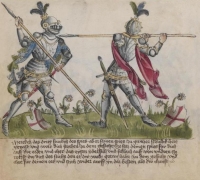 Gladiatoria
Gladiatoria
more >>
small shields resembling jousting shields (due to the characteristic cut-outs to accommodate the lance), however, due to their size, used rather as bucklers.
Leaves from 7 verso to 33 recto show combat techniques with the longsword, sometimes also called the bastard sword or half-sword. It came into use in the 13th century and remained a very popular choice until the end of the Middle Ages. Its length ranged from 110 to 140 cm and, counter-intuitively, it was not heavy – on average it weighted one and a half kilograms. It was called the half-sword because it could be held with both hands (the hilt was longer than in a regular sword), but it was not a full grip. It was held in both hands during combat on foot and in one when mounting a horse. As the images indicate, it was also often held in both hands so that one hand held the hilt and the other the blade, somewhere mid-length (the sword was not sharp there and the hand was clad in iron gauntlets). This popular grip also stemmed from the fact that it facilitated thrusting at the armor with the tip. It was also easier to parry blows (these were received on the edge of the sword between the hand and the hilt) and easier to apply a joint lock or disarm the opponent. Additional the hilt was used as a mace. The images make it apparent that knights fought not only with their sword, but their entire body. When the distances
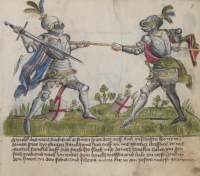 Gladiatoria
Gladiatoria
more >>
between opponents became shortened, combated changed into a wrestling match aimed at knocking the opponent down, some leaves show throws or special techniques involving the sword placed under the foe’s knee to throw him off balance.
Leafs 33 verso to 49 recto present dagger-fighting techniques. It was nearly exclusively used for thrusts, but handling the dagger also required the use of the entire body with numerous joint locks and throws. Leafs from 49 verso to 54 recto depict combat techniques involving the longshield. This peculiar and extraordinary weapon was nearly exclusively used in trials by combat. It resembled a pavise but owing to numerous barbs and spikes it could also be used for offence. The opponents do not wear any armor, only simple clothing. The initial images present techniques involving the shield and sword, the subsequent ones only present the shield held in both hands. Leaf 54 verso shows combat with the longsword and buckler, a small metal shield with a convex metal boss (metal reinforcement in the center of the shield). Such a shield could be used for defense and offence. The next leaf features opponents fighting with falchions – one-handed swords expanding towards the tip, with a single edge and peculiar vambraces (forearm guard) equipped with a sharp spike for thrusting. Leaf 55 verso
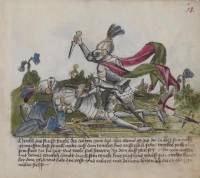 Gladiatoria
Gladiatoria
more >>
presents stick fighting techniques (made famous by the duel of Robin Hood with Little John). These leaves (from 49 verso to 55 verso) present weapons and techniques used during trials by combat where, due to specific laws, rules of combat were often very bizarre. One interesting example is an illustration from another source depicting a fight between a man and a woman. The man, standing up to his waist in a hole, is wielding a mace and the woman, standing on the ground, is equipped with a heavy stone wrapped in a long shawl. Another known case of a fairly bizarre trail by combat is the fight of a knight accused of murder with the victim’s dog (the animal won, thereby proving the knight’s guilt).
Leaves from 56 recto to 59 recto depict wresting techniques in full armor with the use of daggers. In German treatise (such as Gladiatoria) this kind of wrestling was called Ringen, however, here we only see techniques only used in ground fighting, when one opponent knocks the other over (or when both are on the ground).
Facsimile Edition
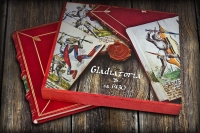 Gladiatoria
Gladiatoria
more >>
The presented facsimile is an extremely interesting account of medieval martial arts – a European tradition that is still being cultivated. There are medieval fencing schools where professional coaches train (based on treatise on fencing and their own experience) modern longsword warriors. These are not the re-enactment groups that have been recently gaining popularity, but martial arts schools in the fashion of those from the Far East. Today the techniques presented in Gladiatoria can be seen in motion owing to training movies, the contemporary form of fencing manuals, published on the internet by these schools.
Specification
Gladiatoria, Germany, ca. 1430
Dimensions: 198 x 208 x 25 mmm
Number of folios: 59
Paper: pergamenata
Binding: Red leather, gold tooling, green lether on the spine with gold title. Hand sewn, natural binding.
Packing: slip in case; dimensions: 200 x 210 x 30 mm
Limited print-run: 99 copies. Available: less than 90 copies
Publisher: Orbis Pictus Publishing House
Price: 740€


